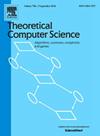旅行比赛问题:基于循环填充的改进算法
IF 1
4区 计算机科学
Q3 COMPUTER SCIENCE, THEORY & METHODS
引用次数: 0
摘要
旅行比赛问题(TTP)是比赛排程表领域中一个著名的基准问题,它要求我们设计一个双循环赛赛程,使每对球队在对方的主场进行一场比赛,使所有n支球队的总距离最小(n为偶数)。TTP-k的问题是,每支球队最多可以连续进行k场主场比赛或客场比赛。本文研究了TTP-k的调度问题,并分析了其解的近似比。大多数以前的表是基于图的哈密顿循环构造的。我们将提出一种基于k循环填充的新结构。然后,结合我们的k循环填充计划和哈密顿循环计划,我们得到了改进的TTP-k近似比。k=3的TTP-3是调查最多的案例之一。对于任意ε>;0,我们将TTP-3的近似比从(1.667+ε)提高到(1.598+ε)。对于TTP-4,我们将近似比从(1.750+ε)提高到(1.700+ε)。通过对哈密顿循环构造的精细分析,我们还将TTP-k的近似比从(5k−72k+ε)提高到(5k2−4k+32k(k+1)+ε)。本文章由计算机程序翻译,如有差异,请以英文原文为准。
The traveling tournament problem: Improved algorithms based on cycle packing
The Traveling Tournament Problem (TTP) is a well-known benchmark problem in the field of tournament timetabling, which asks us to design a double round-robin schedule such that each pair of teams plays one game in each other's home venue, minimizing the total distance traveled by all n teams (n is even). TTP-k is the problem with one more constraint that each team can have at most k-consecutive home games or away games. In this paper, we investigate schedules for TTP-k and analyze the approximation ratio of the solutions. Most previous schedules were constructed based on a Hamiltonian cycle of the graph. We will propose a novel construction based on a k-cycle packing. Then, combining our k-cycle packing schedule with the Hamiltonian cycle schedule, we obtain improved approximation ratios for TTP-k with deep analysis. The case where , TTP-3, is one of the most investigated cases. We improve the approximation ratio of TTP-3 from to , for any . For TTP-4, we improve the approximation ratio from to . By a refined analysis of the Hamiltonian cycle construction, we also improve the approximation ratio of TTP-k from to for any constant .
求助全文
通过发布文献求助,成功后即可免费获取论文全文。
去求助
来源期刊

Theoretical Computer Science
工程技术-计算机:理论方法
CiteScore
2.60
自引率
18.20%
发文量
471
审稿时长
12.6 months
期刊介绍:
Theoretical Computer Science is mathematical and abstract in spirit, but it derives its motivation from practical and everyday computation. Its aim is to understand the nature of computation and, as a consequence of this understanding, provide more efficient methodologies. All papers introducing or studying mathematical, logic and formal concepts and methods are welcome, provided that their motivation is clearly drawn from the field of computing.
 求助内容:
求助内容: 应助结果提醒方式:
应助结果提醒方式:


